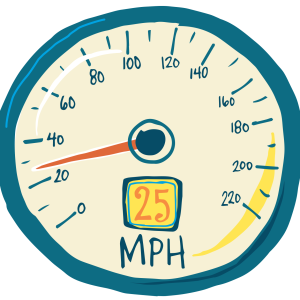 Serious injuries and deaths increase with speed. This is true for drivers and passengers inside a vehicle, as well as people outside the vehicle like walkers, bicyclists, and other drivers. Reducing speeds by even a few miles per hour can mean the difference between life and death.
Serious injuries and deaths increase with speed. This is true for drivers and passengers inside a vehicle, as well as people outside the vehicle like walkers, bicyclists, and other drivers. Reducing speeds by even a few miles per hour can mean the difference between life and death.
What is Target Speed?
Recognizing the need to improve safety, the Central Florida transportation industry is moving toward setting speeds based on a street’s surroundings, called target speed.
Target speed considers these factors:
- Multi-modal activity generated by adjacent land uses;
- Mobility for motor vehicles; and
- Creating a supportive environment for pedestrians, bicyclists, and public transit users.
When examining speeds, planners look at posted, operating, and target speeds. What’s the difference?
- Posted speed = the number on the speed limit sign
- Operating speed = how fast cars are actually going
- Target speed = the speed cars should go for a safe environment, based on the setting of the street (ex: neighborhood, commercial area, industrial area, etc.)
The Florida Department of Transportation (FDOT) developed a “context classification system” that describes areas that range from high densities like urban cores to low densities like natural lands. These context classes are then assigned ranges of speeds that would be appropriate. Learn more in FDOT’s Context Classification Guide, updated in February 2022.
Speed Management Network Analysis Study
MetroPlan Orlando completed a Speed Management Network Analysis in 2022 to examine how fast cars are going and to identify Central Florida roads with critical safety concerns. We used the FDOT system to identify preliminary context classes along city and county roads, and then recommended appropriate target speed ranges for those local roads. Because FDOT had already identified target speeds for state roads, this project focused on identifying city and county roads in need of speed reduction strategies.
Just changing out a speed limit sign doesn’t slow cars down, though. Speed reductions must be accompanied by design changes to create safer conditions. The goal of the analysis is for future projects to incrementally redesign roads to achieve these target speeds, which are typically lower than the existing operating and posted speeds, resulting in improved safety.
Key finding : 176 segments of non-state roads need target speeds that are lower than the existing posted speed limit – meaning that there’s a lot of work to do to achieve safer speeds in the region
Read the full Speed Management Network Analysis report here:
Speed Management Network Analysis – December 2022
What’s next? While the preliminary target speeds presented in this report are a starting point, other aspects — such as access management, on-street parking, and bicycle and pedestrian facilities — should also be considered, and finalized with input from agency and local stakeholders for each project. Some corridors may need more than one project to achieve a recommended target speed.
The Vision Zero Central Florida initiative, in progress, will include additional safety recommendations on how to reduce speeds.
